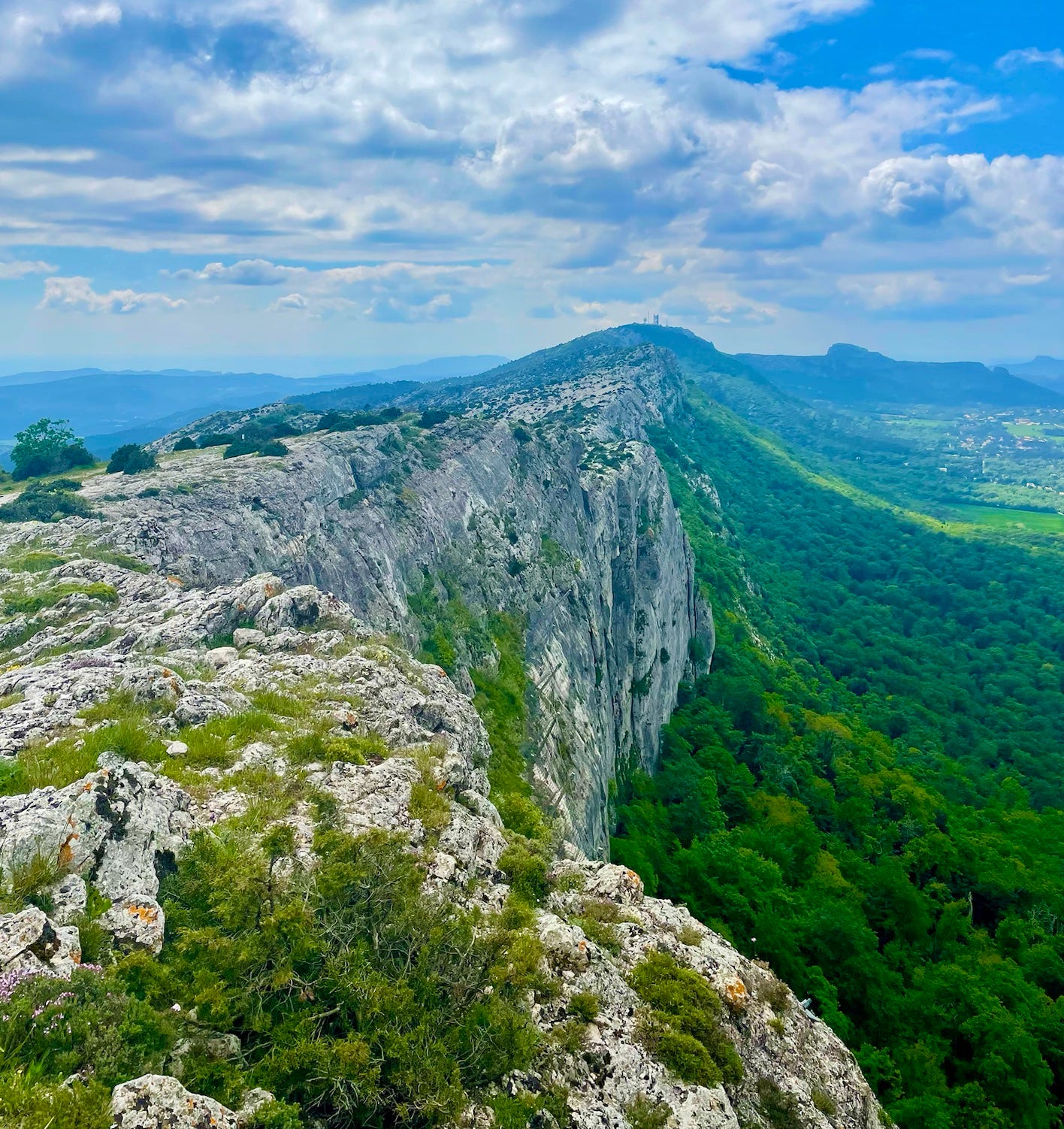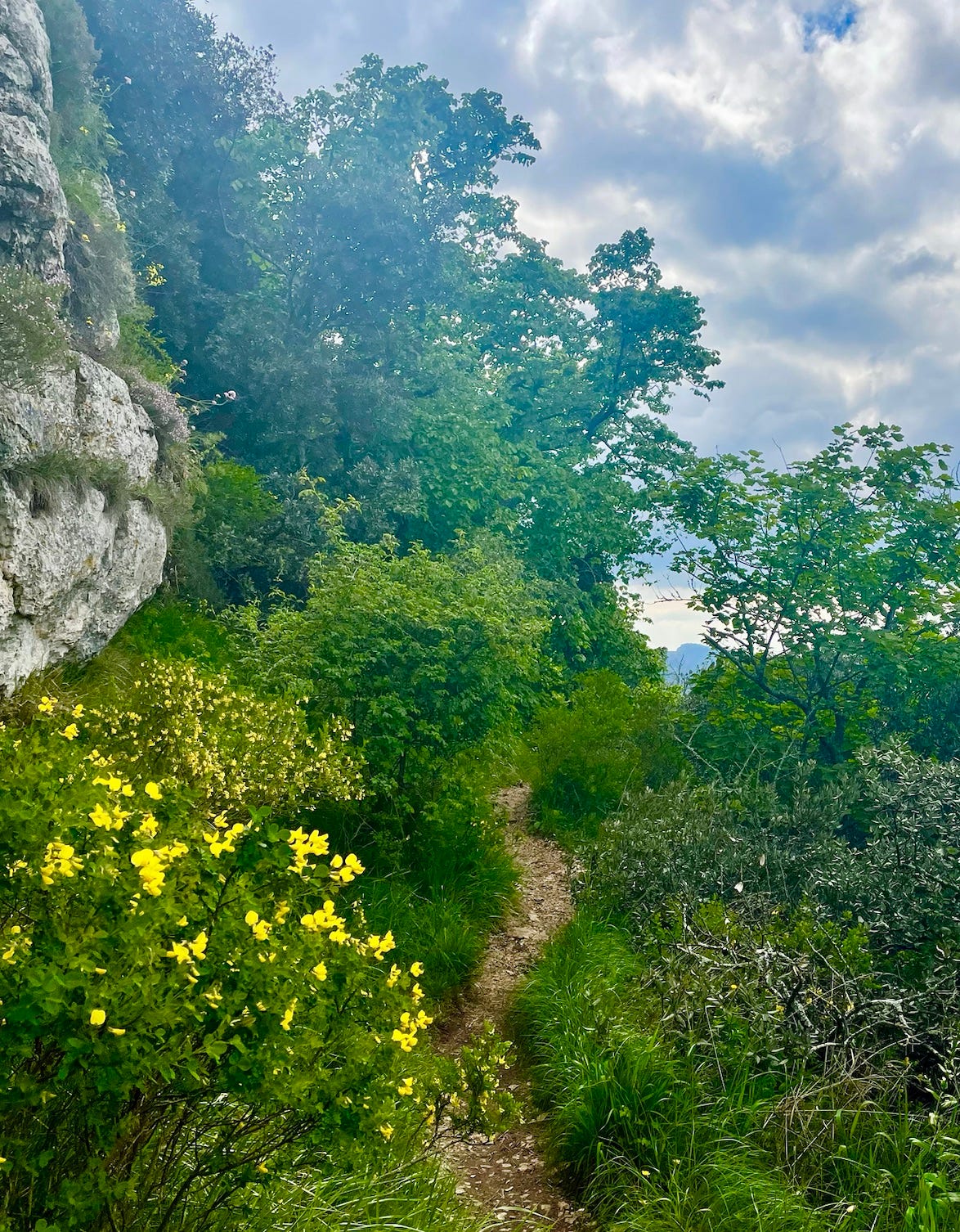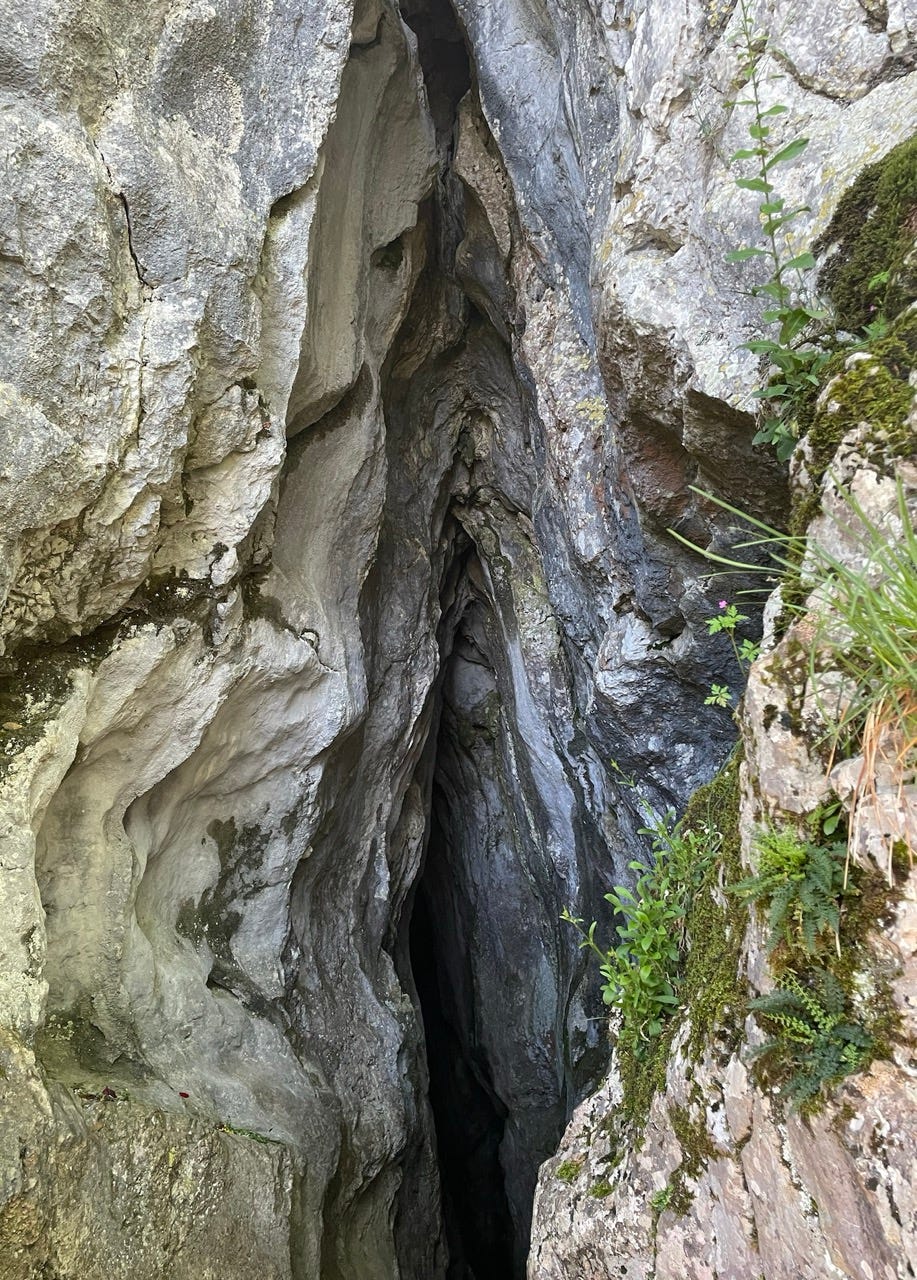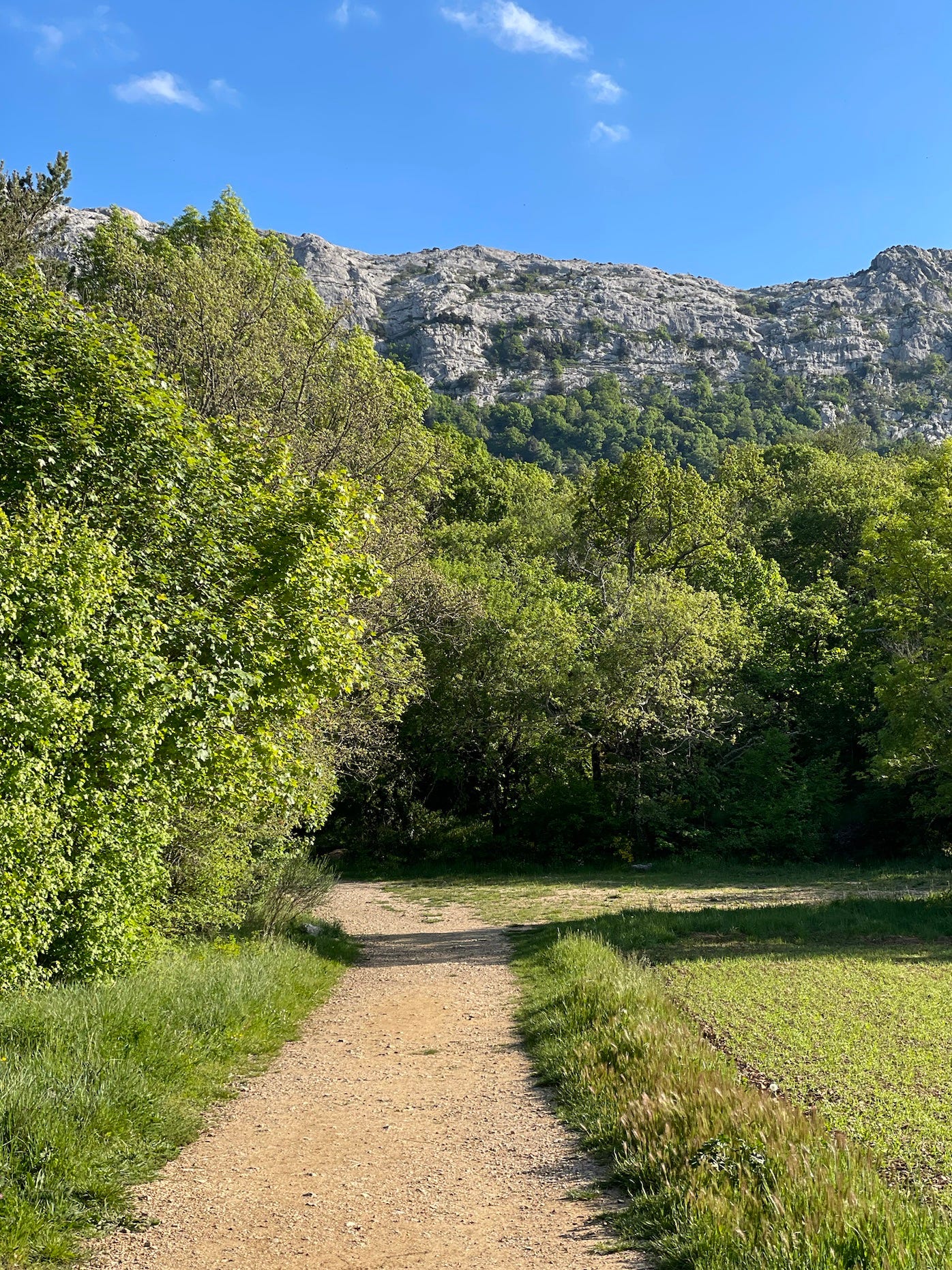She'll Be Falling Down The Mountain
On finding yourself the hard way
The French call it l’appel du vide — “the call of the void” — that feeling that you get when you’re somewhere up high and you feel a sudden, perverse urge to jump. It’s not suicidal; it’s characterized by coming out of nowhere, challenging our reflexes for self-preservation. Hence l’appel, or call — it’s like something calls out and urges you to follow the completely crazy impulse to leap.
I’ve felt this many times, but never thought of it as an urge so much as a kind of felt curiosity: a longing to know what it might feel like to tumble through the air into the unknown. Even that doesn’t quite capture it — it’s almost more of an urge to recapture a feeling that you somehow already know, like déjà vu but with falling. It’s a sense that you can not only imagine what it might feel like to tumble through the air, you already know what it would feel like because somehow, you’ve already experienced it. You already know the sensation of losing your footing or your grip and feeling the ground slip away from you; you know the drop in your stomach, the electric pulse of alarm down the back of your neck and your spine, the sudden pounding of your heart, the sensation of nothingness as everything gives way, the flash of familiarity, the ohyeahright I know this feeling…
You know?
Anyway, that was what I felt as I tumbled over the edge of a cliff on a mountain in the south of France last month.
Pilgrimages are usually pretty straightforward. Usually they just involve a lot of walking along a fairly well-trodden and often pre-determined path — the Camino de Santiago, for example, or the Hajj (the pilgrimage to Mecca). They can be physically taxing — part of the point, arguably, is to push yourself physically — but they usually aren’t inherently dangerous, for the most part. A pilgrimage is not a quest, in the strict sense: the pilgrim goes in search of something, but the search isn’t for something that can be found on the literal path; it’s for something that can only be discovered on the spiritual path, through the step-by-step movement of a journey that has its fullest unfolding in the heart, soul, or spirit. It’s not meant to be a thrilling adventure. You’re certainly not supposed to fall off cliffs.1
In any case, I was not on a pilgrimage last month, not technically. Figuratively, spiritually, certainly — there’s much to be said about simply being in a state of pilgrimage, even if you’re not walking — but technically I was in France to co-lead a retreat and facilitate a storytelling journey for a small group of women. Which is to say, I was responsible for supporting the creative and spiritual pilgrimages of others, not my own, and so going off into circumstances under which I might fall off of a cliff by myself was not on the agenda.
The frame of the experience (and the name of the retreat) was Writing The Heroine’s Journey, which was a little bit tongue in cheek because I am more than a little bit critical of hero’s journeys and some of that criticism extends to standard frames of heroine’s journeys and even kindred journeys and really any journey-focused story framework that draws heavily from the hero’s journey structure and/or connects itself to the idea of a monomyth. My use of it (for the purposes of the retreat, and beyond) leans pretty heavily deconstructionist: interrogating the idea of the hero or heroine in women’s stories, and unpacking the whole framework of journeys. For the retreat in France, we were going to be walking both a figurative and literal landscape, navigating the archetypes of both figurative and literal heroines — ourselves, as authors and as protagonists in our own stories, and Mary Magdalene, whose lore dominates the landscape of that part of France — and exploring, unpacking, and crafting our own stories. This involved a lot of walking up and down mountains, as it happens.
I use the words we and our, because this was absolutely a shared experience, but again, I was there as a teacher and a facilitator, not an explorer. It was not my journey. My personal impulses and desires and curiosities were not part of the map, so to speak; it was crafted very specifically to meet and serve those of the participants. So even though there was one teeny-tiny nagging curiosity that I was carrying from my personal journey/pilgrimage the year before, that nagging curiosity was not going to have a place in the experience, unless some unlikely window of opportunity opened up.
Which it did. Of course it did.
It was on the third full day of the retreat. The focus of this particular day, outside of the story work, was a hike to the very top of the Massif de Sainte Baume, where you can find the Chapelle du Saint-Pilon as well as spectacular views across the valley below, over the dragonspine-like ridge, and all the way out to the Mediterranean Sea. The spot that you climb to is directly above the Grotto of Mary Magdalene, and it’s where Mary is said to have been flown by angels seven times a day for prayer, which makes sense, because it’s a steep and rocky climb and hiking up there just one time in a day is an intense workout even if you’re not a holy person slowed down by robes. Doing more than once honestly wouldn’t be doable without divine assistance.
It’s a long way up, and a long way down. On the hike back down the mountain there’s a fork in the road: one path takes you around to the hike up to Mary’s grotto, another is the main pilgrimage path—the so-called Chemin des Roys— another goes down a different way that takes you more directly to the monastery and its hostellerie, and then one more goes to a clearing directly beneath the rockface underneath the grotto. Beyond this last area is a very, very narrow trail that snakes along the tree line of the mountain, where the forest meets the cliffs; it’s the path that people sometimes take when they’re trying to find le Grotte aux Oeufs — the Cave of Eggs — and it is a notoriously tricky way to get there.
This was my nagging curiosity. I wanted to see if I could get to the Cave of Eggs on my own, taking that path. I had been there the year before, up a more straightforward route from the valley below, but I wanted to see if I could find it myself, by myself, the hard way, for reasons that I can still can’t quite explain to myself or to anyone else. It was just an urge, un appel, a persistent whisper in my psyche. Or it was ego. Or both.
Again, I had no intention of shoe-horning this into the retreat experience; I was fully prepared to let it go until my next visit. But as we made our way down the mountain after our hike to Saint-Pilon and got to the fork in the road, the group began to split up. One wanted to go on her own down the secondary path; two others wanted to go ahead on the Chemin des Roys; everyone could just meet back at the house, which wasn’t that far from the mountain. Here, unexpectedly, was an opportunity to explore the other trail.
I’ll walk Susanna to the other path and then check out the goat trail and then head back down that way, I told
, my co-leader. I’ll meet you all back at the house.I won’t regale you with the details of walking the winding, narrow mountain path; this isn’t a hiking blog. I will say that it was spectacularly beautiful, if a little throat-tightening at times. It was early May, so the path was abundant with mountain wildflowers and blooming trees — wild daffodils, lupine, lilies and apple blossoms — and where the path opened past the trees along the rocks, the whole valley came into view. Birds sang and swooped along the tree line; butterflies came so close I thought they’d land on my shoulder. I was a pilgrim and a Disney Princess all in one.
This, I thought, this is church. My heart was so full I thought it would burst.
Still. It was a tricky trail, as advertised. There were places where it branched upward and the sensible thing seemed to be to keep right and keep gaining elevation. The Cave of Eggs is in the rockface of the mountain, after all, just at the tree line, so why would one go down? I knew that this was one of the common mistakes that people make on this path — they assume that they should keep moving upwards and then find themselves too high up, headed back up the spine of the mountain to the top. So I kept left, angling down.2
But as I forged along, I started to doubt myself: had I gone too far? The wrong way? I was tracking my distance relative to the monastery down in the valley; whenever I broke through a clearing and could see the valley below I’d look for it and try to gauge my distance. How far had I hiked? Had I missed an upward turn and somehow gone past the cave? It was hard to tell how far I’d come — the monastery was literally a thumbnail on the landscape below, and it’s difficult to translate thumbnails into real distance when you’re walking along the side of a mountain nearly 3000 feet from the ground and the thumbnail is a mile or two away.
I began looking for a path up into the rocks. I knew that I would eventually have to wind my way around at least part of the rockface to get to the cave, so the right path had to curve in that direction. It just had to. It didn’t make sense to curve away and down from the rocks. So I looked for a way up.
There were many narrow cutaways through the bushes and into the rocks, but I finally saw one that seemed promising. It looked more well-trodden than the others, like it had been walked recently, and it arced up into a bank of much larger rocks. It didn’t ping my Cave of Eggs radar (which I’d been hoping for) but it all looked very cave-ish, and heading in a cave-ish direction seemed to make more sense than going deeper into the woods. I congratulated myself on being a sensible hiker, and clambered up.
And found nothing. The path ended beneath an unclimbable wall of rock with a steep cliff-drop on the other side. This wasn’t the right way. Ugh. Branches were snagged in my hair and my zen was turning into frustration. How did I get this wrong? Why didn’t I stay on the path? Did I have to turn around and climb back down? It was so frustrating. Couldn’t I just find a way to climb down here and call it a detour rather than a wrong direction? I grabbed onto a branch and leaned over the edge of the cliff to see.
You already know what happened next.
I knew that I was falling before I was fully in the air. I knew that it wasn’t just a slip and that I hadn’t just slid down the rocks. No, the branch had broken and I was fully tumbling forward, away from the rocks and into the air. It was an actual somersault, a flip forward and over, which turned out to be a blessing because if I’d slid I’d have scraped myself against the rocks and if I’d just splatted forward I would have broken my face. By launching, somehow, into the air and flipping over, I cleared some danger. But still, I was falling and while falling I was thinking exactly what I’d always imagined I’d think if I fell over some significant height: oh, right, yeah, of course, this is what it feels like. Déjà fall.
And then: oh shit oh shit oh shit.
I was falling over the edge of a cliff. This was not good. It was a small cliff — 7 feet high or so? — but still. The fall felt interminable, like I was tumbling through time itself. This is what it feels like. This is what feels like. Oh shit this is what falling feels like.
I landed on a bed of damp leaves and wildflowers and pine needles, cushioned by my backpack, right at the edge of the trail that I’d just left.
I lay there for a moment, winded. Was I hurt? Would I even know if I was hurt? I didn’t have any experience falling over cliffs, so I didn’t know. I did know that the wind had been knocked out of me and that I was definitely sore. But sore was good, right? I could feel everything, including a deep sense of embarrassment, which made no sense because I was alone on the side of a mountain with no witnesses other than an owl that had hooted just as I hit the ground. I felt my backpack beneath me; it held a sweater, a journal, a gnome, two large mostly empty plastic water bottles, and some fistfuls of wildflowers and pinecones. I could hear the water bottles crunch as I shifted my weight, and I hoped that they hadn’t leaked and soaked my journal (priorities).
The backpack had broken my fall, as had the bed of flowers and foliage. I got up and checked myself for blood and jutting bones. Everything in my body seemed to be in the right place, and there was only a bit of blood on my hands and forearms where I’d been scratched by branches and rocks. I moved my limbs; everything was working, everything was in place.
Except my glasses. Bizarrely, I checked the top of my head to see if they were there, because that’s always the first place that you look for your glasses when you realize that they’re not on your face. They were, of course, not there; I scanned the ground around me and realized immediately that there would be no finding them in the leaves and bushes even if they had somehow landed nearby, which itself was a stretch given that they had a whole mountainside to fly off into. There was simply too much foliage and underbrush; that, and I couldn’t see for shit.
All there was to do, then, was to continue hiking across the side of a mountain, bruised and half-blind. Because of course I wasn’t stopping; the mountain had tossed me back onto the correct path and so who was I to not continue following it? What would be the point of falling of a cliff if I just got up and turned around and went back the way that I came? Sure, if I’d been hurt I’d probably have thought and done differently, but I was just a bit banged up and scraped and sight-impaired and in any case I was on the right path. The mountain wanted me to find the cave. It had tossed me off a cliff to make sure that I would find the cave.
So I did.
It wasn’t actually all that much further along, and my instinct that it was somewhere in the next bank of rocks had been correct; I’d just gotten cocky and started climbing too soon. Within a few minutes I saw the where the path forked and curved upward into a narrow passage into the rocks and knew that this time, I had found just the right spot. I clambered up and there it was: the Cave of Eggs.
To say that I was exhilarated doesn’t even capture it. I was elated. I had found it. Half blind and a little battered and more than a few twigs in my hair, but still. I had found it.
I stayed for a while, reveling in having the cave all to myself. I might have sang into it, as one does.3 At one point three young French guys appeared from the opposite trail; if they were startled to see a middle-aged woman with pine needles in her hair and dirt and blood on her cheeks, they hid it well. I asked them to take my photo and they obliged and then continued on their way. I decided to take their appearance as a sign — it showed exactly where the route down the mountain was — and so I said goodbye to the cave and headed into the woods.
Getting down the mountain was in some respects more difficult than getting to the cave itself — the forest was dark and full of fallen trees and slippery rocks and I was only able to see a few feet ahead of myself without my glasses. But I knew that if I just kept heading downhill I’d end up in the open valley with line of sight to the road. So I just forged my way along, taking my time and watching my steps, and eventually made it all the way down and out of the forest and onto the path home.
I messaged Patricia. So you know, I texted, I’m safe and en route back.
The “I’m safe” was superfluous. I had not been gone all that long, all things considered; even with my fall, I was still within a very reasonable timeframe for hiking across the mountain and back down to the valley. I knew that Patricia would have been watching the time closely and waiting to hear from me, but the ‘en route back’ would have sufficed. No declaration of safety necessary.
Except that there was a need, for me. I think that I needed to declare it, not as a statement on having survived a fall (which Patricia, thankfully, did not yet know about), but as a declaration of my state of mind — or more accurately, my spirit. The word “safe” derives from the Latin salvus, which can be translated as “not injured” or — more accurately — as “whole.” I wasn’t thinking about this at the time, of course, but this was absolutely my state of mind and spirit. I felt whole. Despite the minor injuries and the impairments of lost glasses, scraped skin, and sore muscles, I felt more fully myself, more wholly myself, than I had in a long time. When I texted, I’m safe, perhaps that’s what I meant: I’m whole. Perhaps that’s what I most wanted Patricia — and myself — to know in that moment.
Hi, just checking in. I’m whole. Back soon.
That’s what makes any journey a pilgrimage, I think — it makes one feel whole, or even just closer to wholeness. It’s a lived reminder that as you navigate the inevitable cliff-falls of life, you can always find your self on the path — your most whole self, even (not to get too spiritually twee here) your most holy self. That’s all that holiness is, maybe: wholeness. Many theologians would disagree with this on translation grounds; I’m relying on the Old English etymology of the word “holy” here (hal and halig, from which we get, respectively hale / whole / healthy and holy) and turning it to my own purposes. So it is, admittedly, a stretch. Greek is more standard for translating the word “holy” in religious contexts, and the primary Greek word for holy, hagios, actually means separate or set apart; so does hieros, which is closer in meaning to “sacred” than “holy” but the sense of separateness still applies.
But maybe that’s fitting, too — to pilgrim or to journey in any context is to separate yourself from a fixed place. It’s answering the call of the void, in a way: you feel a sense of possibility in the unknown, and you let yourself get drawn toward it, even if it means letting go of the things that attach you to permanence, things like roots, home, solid ground. It means letting the ground give way so that you can tumble forward, away from the things that keep you rooted in place. It means letting the tumble carry you, already knowing what it feels like to have let go. Maybe the tumble scares you; maybe it breaks you. That’s the risk, obviously. That’s why it’s hard.
But maybe it’s what puts you on just the right path.
Speaking of the sacred! As threatened, I started a second newsletter for the purposes of writing shorter things on a wider range of topics that have less to do with my personal Eat Pray Love journey. It’s called Sacred(ish) and it’s topically adjacent — the name is a giveaway — in that it’s more than a little woo but in a here is also some philosophy and history and science kind of way. A little feminist theology and literary theory alongside some astrology and tarot and crystal-hoarding, all in shorter form. A snack box of spiritualish things, I think I called it in the first issue last week. A charcuterie of the sacred. For nerdy weirdos who like witchy things; please subscribe if that sounds like you!
I actually went and Googled this, to see how many pilgrims have ever fallen over cliffs. There’s no official number because no-one is keeping track; I could find only one count connected to the Camino, although of course there are many stories of broken bones and twisted ankles. The greatest danger on most pilgrimages is exposure — heat, dehydration, etc..
Occasionally I couldn’t resist doing a little exploring into the rocks — at one point this led me to an ancient abandoned hermitage, which was thrilling in its own right — but that was mostly curiosity rather than pathfinding.
If you’ve read last year’s post about the cave (linked above), you’ll know that there’s a history of me singing in it / at it. The best singing happens inside the cave, but there was no way in hell that I would go down into it on my own. I was content to leave for that for another day, with companions and a rope and a headlamp; the singing had to stay outside.








You are so lucky! This looks beautiful…and very adventurous!
Having tracked the IG version of this experience, I loved reading what it felt like in your heart